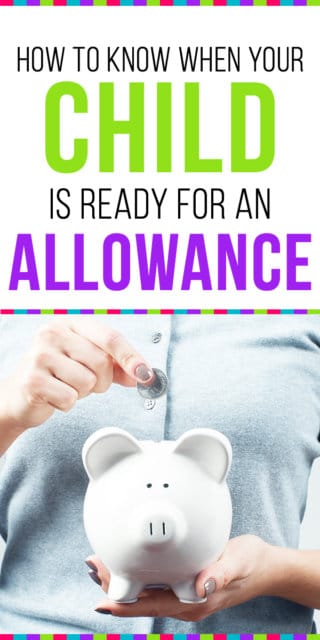Allowances can be a pretty hot topic in the parenting world.

There are so many different views as to how to manage them.
I love the way Gail Vaz-Oxlade explains allowances in her book Money Smart Kids. She says that the purpose of an allowance is to help your kids learn about money management.
You have to be prepared to pay them an allowance without restricting what they can do with it so they can learn from their mistakes.
As with any new skill, you’ll want to make sure your kids are ready to learn it in order to help them be the most successful.
So, how do you know when your kids are ready to learn money management by having an allowance?
When it comes to being ready to learn about money, you can let your kids lead the way.
If they go with you to the store and see you using cash to pay for things, they are exposed to money almost everyday. They will become curious about how money works and show you they are ready to learn more.
When your kids are ready for an allowance, they will:
- Ask questions
- Ask for money
- Nag you at the store
- Ask how they can earn their own money
1. They Ask Questions
Children are naturally curious.
One way they will let you know they are ready for an allowance is by asking you a lot of questions about money. How do you get it? What do you do with it? Why do you need it?
Answer their questions as honestly as you can. Kids learn a lot about money management by observing us so it’s important to explain things as best as you can. I love using books to explain things to my kids.
2. They Ask for Money

Another sign that your kids are ready for an allowance is that they ask you to give them money. My kids always ask for a dollar whenever we’re near those crank machines with the really cheap plastic toys.
If you’re not willing to let your kids waste your money on those machines, that’s a really good sign that it’s time to consider giving them an allowance.
Remember, once you decide to pay your child an allowance, you need to be willing to step back and let them make their own decisions regarding what to spend it on. It’s better that they make mistakes now when the dollar value is low then when they are older and the stakes are much higher.
3. They Won’t Leave You Alone At the Store
Mommy, can you buy me this?
If you’re hearing this a lot when you go to the store, then it’s definitely time to give your child an allowance. The question, “Can you buy me this?” demonstrates that your child understands that we trade money for the things we want and need.
This is a perfect opportunity for you to explain to your child that you can’t always buy them what they want, but they can buy it for themselves by earning money or saving their allowance until they have enough to buy what they want.
This is a great way for children to learn how much things cost too. When kids are really young, they don’t understand that $20 is more than $1 and having to save their money to buy things is a great way to teach this.
4. They Want to Know How They Can Earn Their Own Money
Children are usually taught about money in grade 2 or 3.
If they haven’t had an allowance up to this point, or even if they have, once they understand the value of money, they may start asking how they can earn some. This is a great time to start giving them an allowance.
If your child is already getting an allowance and they’re asking for more money, it’s a great time to talk about other ways they can earn money like selling some of their toys in a garage sale, setting up a lemonade stand, or doing odd jobs for neighbours or family members.
You can also take this opportunity to explain how you earn money.
Communication is Key

It’s important to have conversations with our kids about why we need to earn money and where it comes from.
Credit and debit cards make things really convenient but if we never use cash, kids might draw the conclusion that money comes from a machine and there’s an endless supply.
Make an effort to use cash and explain how credit and debit cards work.
Now that you know a few signs that your child is ready for an allowance, how do you know how much to give them? Or how often to pay them? The answers to these questions are really a matter of personal preference as well as what your experience was like as a child.
Some parents like to pay a regular minimum allowance that’s not dependent on doing chores or obtaining good grades so that kids will learn to do those things without expecting to be paid for them.
Other parents like the idea of paying kids as a reward. Somewhere in the middle might be to pay your child a regular monthly or bi-weekly allowance and then pay them extra for certain tasks you determine ahead of time.
The amount you decide to pay your child for their allowance depends on your budget, the frequency with which you pay the allowance, and your child’s age.
I like the idea of determining the allowance based on your child’s age. In our house, we pay our kids $1 for every year of age they are and we pay them bi-weekly.
However you decide to manage allowances in your family, make sure to involve your child in the process and keep it as consistent as possible.
Now that you know the signs that your child is ready for an allowance, you’ll know when to have those important conversations about money.




Leave a Reply